You are using an out of date browser. It may not display this or other websites correctly.
You should upgrade or use an alternative browser.
You should upgrade or use an alternative browser.
Sprinter [Spy Shots] Next generation Mercedes-Benz Sprinter
- Thread starter Rainer271
- Start date
The Mercedes-Benz Sprinter is a light commercial vehicle built by Mercedes-Benz as a large van, chassis cab, minibus, and pickup truck. In the past, the Sprinter had been sold under the Mercedes-Benz, Dodge, and Freightliner nameplates. In the U.S., it was built from complete knock down (CKD) kits by Freightliner. Re-badged and re-engined Sprinters were also sold by Volkswagen Commercial Vehicles as the Volkswagen LT and the Volkswagen Crafter. They are now primarily marketed by Mercedes-Benz. In the Mercedes-Benz van lineup, the Sprinter is the largest model offered, followed by the mid-size Vito (aka Viano, V-Class, and EQV) and small Citan.
Wolfgang
Kraftwagen König
Mercedes-Benz Dusseldorf plant celebrates start of production of the Mercedes-Benz eSprinter
- Production of the fully electric eSprinter heralds a new era in Dusseldorf
- Dusseldorf is the competence centre for Sprinter vehicles with electric drive
- Good production utilisation in 2019 despite modification
- Two new product run-ups within 21 months with investments totalling around 330 million euros
The Stuttgart-based manufacturer has been building its globally successful vans in Dusseldorf since 1962. Ever since, the plant has continually developed to become in recent years the leading Sprinter plant worldwide and to serve as a benchmark for the other locations. The implementation of future-oriented technologies and production methods as well as their consistent testing benefits the entire production network of Mercedes-Benz Vans.
More than 4.6 million vehicles have been produced in Dusseldorf to date. Since 2018, production of the new Sprinter has also taken place there, with over 200,000 units having already left the assembly line, ready to enter into their daily service all over the world. The production of the fully electric eSprinter marks the beginning of a new era in Dusseldorf. Building the eSprinter in Dusseldorf is a next step for the future of the plant and for the manufacturer itself. Over the past years, already in advance of production of the new Sprinter and the new drive system variants, Mercedes-Benz Vans has invested a total of around 330 million euros in the technical expansion of production, while taking into account the fact that, in future, the manufacture of both conventionally operated and fully electric vehicles will be built on a single production line. The result will be enormous flexibility and the ability to meet both customer and market requirements. Besides the comprehensive investments in the production systems, the plant has also been massively investing in the basic and advanced training of its own employees. Since the decision was made to build the eSprinter in Dusseldorf, the plant has become the competence centre for electric drives and has developed the requisite expertise. To date over 2,400 employees have been trained for handling and assembling the high-voltage technologies.
Sustainable production for sustainable profitability
Mercedes-Benz Vans banks on sustainability not only in the products that it consistently electrifies and further optimises, but in particular in its own production as well. The goal is to make all van production CO2-neutral by 2022. To this end various measures have been initiated as part of the so-called green production strategy: energy purchasing at the Dusseldorf plant has also been consistently switching to green energy, and from 2022 electric power is to be procured from 100 percent renewable sources only. The CO2 balance sheet of transportation within the plant is also being addressed: at present, new mobility systems, such as on-demand plant shuttles, are being implemented in Dusseldorf. In addition, since 2012 the Dusseldorf plant has already been a paperless factory and is increasingly relying on automatically guided fuel-cell vehicles. All these measures supplement one another and promote the speedy realisation of the ambitious objectives set by the plant itself, to make a lasting contribution to climate protection.
Flexibility and adaptability to individual utilization profiles
The Mercedes-Benz eSprinter is intended to cover the broadest possible range of use in urban mobility. Accordingly, it is initially being offered as a panel van with high roof and a permissible gross weight of 3,500 kilogrammes. Its maximum loading volume is 10.5 m3, the same as for the Sprinter with combustion engine. Similar to the entry-level diesel engine, the electric drive in the eSprinter drives the front wheels with an output of 85 kW and a torque figure of up to 300 Newton metres.
A flexible payload and battery concept moreover allow adaptation to individual needs for practical use as the customer can choose between three or four battery units. Equipped with a battery capacity of 55 kWh, its range is an estimated 168 kilometres [1], [2] with a maximum payload of 891 kilogrammes. A second battery option takes into account other priorities in the use parameters: three instead of four battery units with a capacity of 35 kWh allow a range of around 115 kilometres [1], [2]. In return, the maximum payload increases by around 140 to approximately 1040 kilogrammes. The integrated fast-charging function provides for more flexibility; 80 percent of the battery charge can be replenished within 30 minutes. The maximum speed can be configured to suit the task at hand: the top speed can be set at 80 km/h, 100 km/h or even as high as 120 km/h, if speed is essential.
[1] Energy consumption and range have been determined on the basis of Directive 692/2008/EC. Energy consumption and range are dependent on the vehicle configuration, and in particular on the selected maximum speed restriction.
[2] The actual range is furthermore dependent upon the individual driving style, the road and traffic conditions, outside temperature, use of climate control/heating system, etc. and may differ.
Source: Mercedes-Benz Passion Blog
Wolfgang
Kraftwagen König
MB Passion tests the eSprinter in München

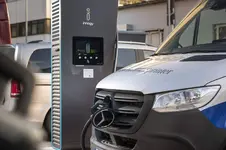
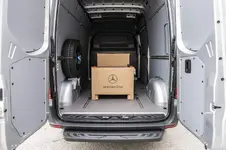


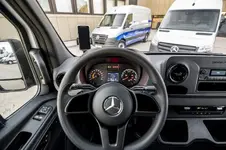


Conclusion:
With the eSprinter model, Mercedes-Benz is bringing a vehicle specifically for urban logistics traffic, a target group for which the model will be very usable. In addition, the model is completely suitable for everyday use and is unproblematic and can flow freely in city traffic even when loaded. The founder of his segment comes electrified to the end customer as the second commercially used model - after the eVito. What is still missing are the deliveries. Orders are to be accepted in February, with the first deliveries expected around May 2020. However, prices for the eSprinter were not yet mentioned.
What we noticed:
- Service interval for the eSprinter every 40,000 km or annually
- First four maintenance services included in the purchase price
- Battery certificate is valid for 8 years or 100,000 km for at least 70%
- Energy saving mode: Vehicle detects when the driver opens the door too often, e.g. in delivery traffic and switches to energy-saving mode (shown in the display, not in the “C” driving program)
- Front charging socket usually more advantageous for permanently attached cables at charging stations
- The standard steering wheel. The 180 euros leather steering wheel is a more than worthwhile investment - both for the combustion engine Sprinter and the eSprinter.
Source: MB Passion
Wolfgang
Kraftwagen König
More than 300 slightly storm damaged Sprinter chassis may come to auction soon, with big discounts. 

Are you planning to build a motorhome? Check out these Sprinters.
Here’s something you don’t see every day - a lot of more than 300 Mercedes-Benz Sprinters from the 2019 model year listed for sale by Copart, the online platform that provides vehicle auction and remarketing services. While we’ve seen tons of interesting cars for sale from the company, these chassis cabs are virtually brand new and are all listed at a price way below the model’s MSRP.
Even the base 2019 Sprinter Chassis Cab 3500 starts at $39,790 and goes up to $41,790 if you want the longer 4500 version. In turn, some of the vehicles from Copart’s auction have a buy-it-now price of just $21,600, and one of the loaded examples is listed for $23,500.
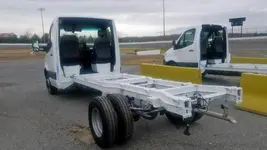


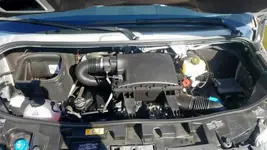


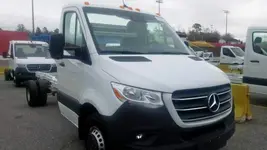
A few things need to be addressed here, however. According to Copart, the Sprinters have “minor damage from a previous storm” and all have “a Florida Dealer Only clean title and bare chassis so they can be tailored to fit your needs." We imagine this as the perfect opportunity to build your own motorhome using a brand new Sprinter as a base.
Of course, you could always use a new Sprinter for your business but you’ll need to find someone who can install a cargo box behind the cabin as these are all just bare frame chassis vehicles.
As a reminder, for the 2019 model year, the Sprinter had just a single engine available - a 3.0-liter, six-cylinder diesel mill with 190 horsepower (142 kilowatts) and 325 pound-feet (440 Newton-meters) of torque. Channeling the power to the rear wheels is a seven-speed automatic gearbox.
motor1.com/news/396723/300-mercedes-sprinters-auctioned/
Are you planning to build a motorhome? Check out these Sprinters.
Here’s something you don’t see every day - a lot of more than 300 Mercedes-Benz Sprinters from the 2019 model year listed for sale by Copart, the online platform that provides vehicle auction and remarketing services. While we’ve seen tons of interesting cars for sale from the company, these chassis cabs are virtually brand new and are all listed at a price way below the model’s MSRP.
Even the base 2019 Sprinter Chassis Cab 3500 starts at $39,790 and goes up to $41,790 if you want the longer 4500 version. In turn, some of the vehicles from Copart’s auction have a buy-it-now price of just $21,600, and one of the loaded examples is listed for $23,500.







A few things need to be addressed here, however. According to Copart, the Sprinters have “minor damage from a previous storm” and all have “a Florida Dealer Only clean title and bare chassis so they can be tailored to fit your needs." We imagine this as the perfect opportunity to build your own motorhome using a brand new Sprinter as a base.
Of course, you could always use a new Sprinter for your business but you’ll need to find someone who can install a cargo box behind the cabin as these are all just bare frame chassis vehicles.
As a reminder, for the 2019 model year, the Sprinter had just a single engine available - a 3.0-liter, six-cylinder diesel mill with 190 horsepower (142 kilowatts) and 325 pound-feet (440 Newton-meters) of torque. Channeling the power to the rear wheels is a seven-speed automatic gearbox.
motor1.com/news/396723/300-mercedes-sprinters-auctioned/
Wolfgang
Kraftwagen König
Mercedes-Benz Sprinter Drinks Diesel With New 161-HP Engine Option

For a work van, this one has an impressive list of standard features.
In late 2020, the Mercedes-Benz Sprinter gets a new, 2.0-liter four-cylinder turbodiesel engine in the United States. The mill makes 161 horsepower (120 kilowatts) and 266 pound-feet (361 Newton-meters) of torque. It exclusively hooks up to a seven-speed automatic gearbox with rear-wheel drive. The setup should be great for anyone looking for a cargo van for hauling a whole lot of stuff.
The Sprinter with the new four-cylinder diesel has a max payload of 6,636 pounds (3,010 kilograms). It comes standard with features like load-adaptive electronic stability control, trailer hitch prep package, keyless start, and brake hold functionality. The suite of safety assistance tech includes blind-spot monitoring, park assist, traffic sign recognition, crosswind assist, driver attention monitoring, lane-keeping assist, and adaptive cruise control.
There's also an extensive options list. Customers can add features like power front seats, electric-sliding door, heated windshield, and automatic climate control. It's even possible to outfit the interior with things like shelving, a workbench, or heavy-duty floors for carrying heavier loads.

The new engine slots into the middle of the powertrain range. The Sprinter is currently available with a gas-fueled 2.0-liter four-cylinder that makes 188 hp (140 kW) and 258 lb-ft (350 Nm). There's also a 3.0-liter turbodiesel V6 with 188 hp and 325 lb-ft (441 Nm).
The four-cylinder diesel will be available for the Cargo version of the van in three configurations: the 144-inch wheelbase for $38,770, 170-inch wheelbase for $44,100, and the high-roof version of the 170-inch wheelbase for $45,950 (plus a $1,495 destination charge). For comparison, the least expensive version of the Sprinter Cargo with the gas-fueled four-cylinder starts at $34,495. With the V6, it would be $40,620.

 motor1.com
motor1.com
For a work van, this one has an impressive list of standard features.
In late 2020, the Mercedes-Benz Sprinter gets a new, 2.0-liter four-cylinder turbodiesel engine in the United States. The mill makes 161 horsepower (120 kilowatts) and 266 pound-feet (361 Newton-meters) of torque. It exclusively hooks up to a seven-speed automatic gearbox with rear-wheel drive. The setup should be great for anyone looking for a cargo van for hauling a whole lot of stuff.
The Sprinter with the new four-cylinder diesel has a max payload of 6,636 pounds (3,010 kilograms). It comes standard with features like load-adaptive electronic stability control, trailer hitch prep package, keyless start, and brake hold functionality. The suite of safety assistance tech includes blind-spot monitoring, park assist, traffic sign recognition, crosswind assist, driver attention monitoring, lane-keeping assist, and adaptive cruise control.
There's also an extensive options list. Customers can add features like power front seats, electric-sliding door, heated windshield, and automatic climate control. It's even possible to outfit the interior with things like shelving, a workbench, or heavy-duty floors for carrying heavier loads.
The new engine slots into the middle of the powertrain range. The Sprinter is currently available with a gas-fueled 2.0-liter four-cylinder that makes 188 hp (140 kW) and 258 lb-ft (350 Nm). There's also a 3.0-liter turbodiesel V6 with 188 hp and 325 lb-ft (441 Nm).
The four-cylinder diesel will be available for the Cargo version of the van in three configurations: the 144-inch wheelbase for $38,770, 170-inch wheelbase for $44,100, and the high-roof version of the 170-inch wheelbase for $45,950 (plus a $1,495 destination charge). For comparison, the least expensive version of the Sprinter Cargo with the gas-fueled four-cylinder starts at $34,495. With the V6, it would be $40,620.

Mercedes-Benz Sprinter Drinks Diesel With New 161-HP Engine Option
The Mercedes-Benz Sprinter gains a third engine option. It's a 2.0-liter turbodiesel making 161 hp and 266 lb-ft.
Wolfgang
Kraftwagen König

Mercedes-Benz schließt sich dem Climate Pledge an und liefert mehr als 1.800 Elektrofahrzeuge für die Amazon Lieferflotte in Europa
Die beauftragten Elektrofahrzeuge werden ab 2020 für Kundenlieferungen eingesetzt und tragen dazu bei, TausendDer Climate Pledge, der von Amazon und Global Optimism mitbegründet wurde, ist eine Selbstverpflichtung, bis 2040, zehn Jahre vor der Zielmarke des Pariser Klimaschutzabkommens, CO2-neutral…
Wolfgang
Kraftwagen König
Mercedes eSprinter Headed To U.S. To Compete With Ford E-Transit

Ford revealed the new E-Transit, the all-electric version of the Ford Transit, just last month ahead of its launch, which is scheduled for late 2021. But it appears that the E-Transit won’t be alone in the all-electric commercial van arena in America, as Automotive News is reporting that the Mercedes eSprinter, already on sale in Europe, will launch in the U.S. as early as Q3 in 2023.

Previously, Mercedes was hesitant to sell the eSprinter in the U.S. because of its limited range and high cost of homologation, but the rising demand for electric delivery vans has prompted the automaker to change course. The Mercedes eSprinter and E-Transit will be joined by a host of new offerings in the coming years, including all-electric delivery vans from Arrival, General Motors, and Rivian.
As companies seek to take advantage of the lower operating costs electric vehicles provide, Guidehouse Insights predicts that battery-powered light commercial vehicle sales, which have totaled around 56,000 units this year, will rise to 623,000 by 2030.

Automotive News is also reporting that the U.S. Mercedes eSprinter could receive a larger, 120-kilowatt-hour battery compared to the 55 kWh unit used in the European version, which would improve range considerably. Currently, that model offers a range of just 96 miles, while the E-Transit is rated to provide 126 miles of range.
Ford and General Motors control over 70 percent of the large van market in the U.S., a highly profitable segment for automakers. Those big two will face increasing competition as the market shifts toward electric vehicles in the coming years. Retailing giant Amazon recently ordered 100,000 EV vans from upstart automaker Rivian, while UPS has ordered 10,000 electric delivery vans from British startup Arrival.

As for the Mercedes eSprinter, its 2023 arrival is expected to coincide with a refresh for the Sprinter van it’s based on. Right now, it’s unclear if the eSprinter will be built at Mercedes’ existing factory in North Charleston, South Carolina, or if the automaker will build it elsewhere and import it to the U.S.

 fordauthority.com
fordauthority.com
Ford revealed the new E-Transit, the all-electric version of the Ford Transit, just last month ahead of its launch, which is scheduled for late 2021. But it appears that the E-Transit won’t be alone in the all-electric commercial van arena in America, as Automotive News is reporting that the Mercedes eSprinter, already on sale in Europe, will launch in the U.S. as early as Q3 in 2023.
Previously, Mercedes was hesitant to sell the eSprinter in the U.S. because of its limited range and high cost of homologation, but the rising demand for electric delivery vans has prompted the automaker to change course. The Mercedes eSprinter and E-Transit will be joined by a host of new offerings in the coming years, including all-electric delivery vans from Arrival, General Motors, and Rivian.
As companies seek to take advantage of the lower operating costs electric vehicles provide, Guidehouse Insights predicts that battery-powered light commercial vehicle sales, which have totaled around 56,000 units this year, will rise to 623,000 by 2030.
Automotive News is also reporting that the U.S. Mercedes eSprinter could receive a larger, 120-kilowatt-hour battery compared to the 55 kWh unit used in the European version, which would improve range considerably. Currently, that model offers a range of just 96 miles, while the E-Transit is rated to provide 126 miles of range.
Ford and General Motors control over 70 percent of the large van market in the U.S., a highly profitable segment for automakers. Those big two will face increasing competition as the market shifts toward electric vehicles in the coming years. Retailing giant Amazon recently ordered 100,000 EV vans from upstart automaker Rivian, while UPS has ordered 10,000 electric delivery vans from British startup Arrival.
As for the Mercedes eSprinter, its 2023 arrival is expected to coincide with a refresh for the Sprinter van it’s based on. Right now, it’s unclear if the eSprinter will be built at Mercedes’ existing factory in North Charleston, South Carolina, or if the automaker will build it elsewhere and import it to the U.S.

Mercedes eSprinter Headed To U.S. To Compete With Ford E-Transit
The Mercedes eSprinter electric van is headed to the U.S. in 2023 to compete with the Ford E-Transit and several other EV vans in the works.
Wolfgang
Kraftwagen König
Klaus Rehkugler dropped more hints about the new MB Vans Electric Versatility platform. 



Also mentioned a 100 kW battery and an arrival date of before 2025.

 logistra.de
logistra.de
Also mentioned a 100 kW battery and an arrival date of before 2025.

Mercedes-Benz Vans: eCitan und flexible Architektur für eSprinter
Anlässlich eines digitalen Roundtable über ein herausforderndes Jahr, das der Hersteller aber noch ordentlich abschließt, kündigt die Van-Sparte des Daimler-Konzerns eine Elektrifizierungsoffensive an.
Wolfgang
Kraftwagen König
MB Passion has the story. 

Mercedes-Benz Vans announces next-generation eSprinter based on newly developed ”Electric Versatility Platform”

"The next generation eSprinter will enable us to make many more body variants available. This will ensure we meet the requirements of our customers across multiple sectors in the future, while offering the advantages of locally emission-free electric drive," said Marcus Breitschwerdt, Head of Mercedes-Benz Vans. "The Sprinter has been demonstrating our competence in the transport field for a quarter of a century. In the field of electromobility, we have initiated many innovations in recent years. With the implementation of our accelerated electrification strategy, we’re combining the best of both worlds – our innovation and expertise!"
Mercedes-Benz is convinced of the ecological and economic advantages of battery-electric vans and will continue to push forward its plans to bring electrically powered vans to the market in all segments. The Mercedes-Benz Vans division is accelerating its electrification strategy and pursuing leadership in electric drive by fast-tracking development of its new Electric Versatility Platform for the large van segment. This innovative e-drive platform will underpin the next generation of eSprinter, a product that will aim for best-in-class performance. With an investment of 350 million euros, the Electric Versatility Platform will play a key role in Mercedes-Benz Vans’ plans for emission-free transportation, and will offer optimal solutions, including for the U.S. and Canada. As the next generation eSprinter will be produced CO2 neutral, this will be yet another step toward realizing Daimler’s ”Ambition 2039.”

Today, Mercedes-Benz Vans is already the EV market leader with a share of more than 30% of the midsize and large van segments in Europe. Following the eVito and eSprinter, Mercedes-Benz Vans will ultimately cover the battery-electric range in all commercial transporter segments with the future eCitan.
The development of the Electric Versatility Platform significantly underlines the refocused Mercedes-Benz Vans’ strategy, which, among other things, enshrines leadership in the field of electromobility.

Mercedes-Benz Vans has refocused its strategy in line with the passenger car division, focusing on the following subject areas:
Mercedes-Benz Vans announces next-generation eSprinter based on newly developed ”Electric Versatility Platform”
- Next-generation eSprinter will offer optimal solutions, including for U.S. and Canada
- 350 million euro investment in Electric Versatility Platform
- Requirements for eSprinter defined in close collaboration with customers: Three battery and multiple body configurations make next-generation eSprinter perfect fit for nearly every business from panel van and people mover to chassis for box bodies
- Platform plays key role in advancing Mercedes-Benz Vans’ strategy: Leading in electromobility and profitable growth worldwide
"The next generation eSprinter will enable us to make many more body variants available. This will ensure we meet the requirements of our customers across multiple sectors in the future, while offering the advantages of locally emission-free electric drive," said Marcus Breitschwerdt, Head of Mercedes-Benz Vans. "The Sprinter has been demonstrating our competence in the transport field for a quarter of a century. In the field of electromobility, we have initiated many innovations in recent years. With the implementation of our accelerated electrification strategy, we’re combining the best of both worlds – our innovation and expertise!"
Mercedes-Benz is convinced of the ecological and economic advantages of battery-electric vans and will continue to push forward its plans to bring electrically powered vans to the market in all segments. The Mercedes-Benz Vans division is accelerating its electrification strategy and pursuing leadership in electric drive by fast-tracking development of its new Electric Versatility Platform for the large van segment. This innovative e-drive platform will underpin the next generation of eSprinter, a product that will aim for best-in-class performance. With an investment of 350 million euros, the Electric Versatility Platform will play a key role in Mercedes-Benz Vans’ plans for emission-free transportation, and will offer optimal solutions, including for the U.S. and Canada. As the next generation eSprinter will be produced CO2 neutral, this will be yet another step toward realizing Daimler’s ”Ambition 2039.”
Today, Mercedes-Benz Vans is already the EV market leader with a share of more than 30% of the midsize and large van segments in Europe. Following the eVito and eSprinter, Mercedes-Benz Vans will ultimately cover the battery-electric range in all commercial transporter segments with the future eCitan.
The development of the Electric Versatility Platform significantly underlines the refocused Mercedes-Benz Vans’ strategy, which, among other things, enshrines leadership in the field of electromobility.
Mercedes-Benz Vans has refocused its strategy in line with the passenger car division, focusing on the following subject areas:
- Clear positioning as a premium brand for commercial and private customers
Mercedes-Benz Vans is sharpening its profile as a premium provider of future-oriented transport solutions for commercial and private customers. - Leveraging growth potential
Central to the new strategy is a disciplined focus on sales and high-margin markets and segments to advance profitable growth worldwide. In parallel with the expansion of its activities in Europe, the company will continue to grow its presence in China and North America. - Intensifying customer loyalty and growing recurrent revenues
Mercedes-Benz Vans will further intensify its cooperation with customers to ensure products and services are perfectly tailored to their needs. - Leading position in electric drives and digital solutions
Mercedes-Benz Vans' objective is to set new standards in the van segment with customer- and future-oriented solutions. In addition to electromobility, the networking of vehicles and digital solutions are also consistently being further developed. - Reduced costs
In order to improve profitability and increase competitiveness, fixed costs will be reduced. Profitability also plays a key role against the backdrop of the transformation to emission-free and connected mobility.
https:///2020/12/naechster-e-sprinter-mit-neuer-plattform-angekuendigt/
Wolfgang
Kraftwagen König
Mercedes-Benz Vans Introduces 4-Cylinder Diesel Sprinter for the Canadian market

Mercedes-Benz Vans is pleased to announce the introduction of a 2.0 litre 4-cylinder diesel engine for the Sprinter van. This advanced powertrain produces 161 hp and 266 lb-ft of torque. Paired with a 7-speed automatic transmission, it offers customers a highly compelling option that satisfies countless industry needs, as well as a wide-range of transportation requirements. Similar to the 3.0 litre 6-cylinder diesel engine, the 2.0 litre 4-cylinder diesel engine will be offered on all body types: Cargo, Crew, Passenger, and Cab Chassis variants. The 2.0 litre 4-cylinder diesel Sprinter will be arriving in dealerships in early spring of 2021.
The 4-cylinder diesel engine can be combined with a rear-wheel drive configuration with various wheelbase options, including the 144" wheelbase standard roof or the 170" wheelbase and 170" extended wheelbase high roof offering. With low fuel consumption, high torque, and high elasticity at low speeds, the 4-cylinder diesel variant offers additional advantages to an already attractive product offering. The 4-cylinder diesel engine joins the 6-cylinder diesel and the 4-cylinder gasoline engine, rounding out the comprehensive Sprinter engine lineup for a total of three different powertrain options.
The 2021 Mercedes-Benz Sprinter comes equipped with an array of standard features; including Keyless Start, Multifunctional steering wheel, Active Break Assist, Cruise Control as well as heated and power-adjustable side mirrors. These features ensure each van is equipped with the class-leading technology, safety and reliability expected from Mercedes-Benz Vans.
Since its market launch, the Sprinter continues to set the commercial van benchmark through top of service, safety, and total cost of ownership (TCO). With the introduction of the new generation Sprinter, Mercedes-Benz underscored its role as a pioneer and innovator bringing modern safety and driver assistance technologies to the large van segment. The 2021 Sprinter continues this trend, and is equipped with a range of optional safety and assistance systems such as Active Lane Keeping Assist, Active Distance Assist DISTRONIC, and Blind Spot Assist, which, until recently, were exclusive to Mercedes-Benz passenger cars.
With advanced features on par with the Mercedes-Benz passenger car lineup, the innovative Mercedes-Benz User Experience (MBUX) multimedia system, a compelling design, and a multitude of options available for the rear-wheel and four-wheel drive variants, the versatile Sprinter offers an enticing solution to meet the wide and ever-growing requirements of valued Mercedes-Benz vans customers.
Source: Mercedes-Benz Vans Canada
Mercedes-Benz Vans is pleased to announce the introduction of a 2.0 litre 4-cylinder diesel engine for the Sprinter van. This advanced powertrain produces 161 hp and 266 lb-ft of torque. Paired with a 7-speed automatic transmission, it offers customers a highly compelling option that satisfies countless industry needs, as well as a wide-range of transportation requirements. Similar to the 3.0 litre 6-cylinder diesel engine, the 2.0 litre 4-cylinder diesel engine will be offered on all body types: Cargo, Crew, Passenger, and Cab Chassis variants. The 2.0 litre 4-cylinder diesel Sprinter will be arriving in dealerships in early spring of 2021.
The 4-cylinder diesel engine can be combined with a rear-wheel drive configuration with various wheelbase options, including the 144" wheelbase standard roof or the 170" wheelbase and 170" extended wheelbase high roof offering. With low fuel consumption, high torque, and high elasticity at low speeds, the 4-cylinder diesel variant offers additional advantages to an already attractive product offering. The 4-cylinder diesel engine joins the 6-cylinder diesel and the 4-cylinder gasoline engine, rounding out the comprehensive Sprinter engine lineup for a total of three different powertrain options.
The 2021 Mercedes-Benz Sprinter comes equipped with an array of standard features; including Keyless Start, Multifunctional steering wheel, Active Break Assist, Cruise Control as well as heated and power-adjustable side mirrors. These features ensure each van is equipped with the class-leading technology, safety and reliability expected from Mercedes-Benz Vans.
Since its market launch, the Sprinter continues to set the commercial van benchmark through top of service, safety, and total cost of ownership (TCO). With the introduction of the new generation Sprinter, Mercedes-Benz underscored its role as a pioneer and innovator bringing modern safety and driver assistance technologies to the large van segment. The 2021 Sprinter continues this trend, and is equipped with a range of optional safety and assistance systems such as Active Lane Keeping Assist, Active Distance Assist DISTRONIC, and Blind Spot Assist, which, until recently, were exclusive to Mercedes-Benz passenger cars.
With advanced features on par with the Mercedes-Benz passenger car lineup, the innovative Mercedes-Benz User Experience (MBUX) multimedia system, a compelling design, and a multitude of options available for the rear-wheel and four-wheel drive variants, the versatile Sprinter offers an enticing solution to meet the wide and ever-growing requirements of valued Mercedes-Benz vans customers.
Source: Mercedes-Benz Vans Canada
Similar threads
- Replies
- 3
- Views
- 5,685
- Locked
- Replies
- 643
- Views
- 178,261
- Replies
- 743
- Views
- 77,842
- Replies
- 89
- Views
- 12,481
Mercedes-Benz
Mercedes-Benz Group AG is headquartered in Stuttgart, Germany.
Established in 1926, Mercedes-Benz Group produces consumer luxury
vehicles and light commercial vehicles badged as Mercedes-Benz, Mercedes-AMG,
and Mercedes-Maybach.
Its origin lies in Daimler-Motoren-Gesellschaft's 1901 Mercedes
and Carl Benz's 1886 Benz Patent-Motorwagen, which is widely regarded
as the first internal combustion engine in a self-propelled automobile.
The slogan for the brand is "the best or nothing".
Official website: Mercedes-Benz (Global), Mercedes-Benz (USA)
Official website: Mercedes-Benz (Global), Mercedes-Benz (USA)
Trending content
-
GERMAN CAR FORUM
German Car Forum is an online community established in 2005, designed for car enthusiasts. It is a member-driven platform and news aggregator, providing the latest information and updates on various automobile brands. -
QUICK NAVIGATION
-
USER MENU